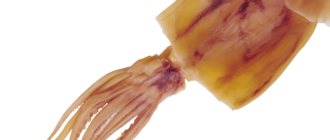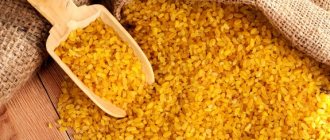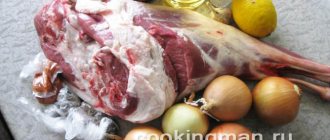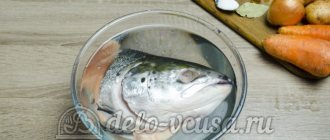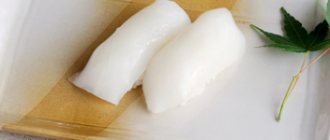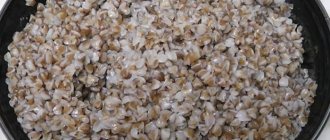Squids are ten-armed edible mollusks of the cephalopod order, which are simply irreplaceable in cooking. Hundreds of dishes are prepared from this sea creature: salads, soups, snacks. For example, crispy rings in batter can be served both as an appetizer and as an addition to the holiday table. And to make the food tasty, you need to know how to properly clean squid. There are many secrets and rules in this process.
In general, if you have this “rare guest” product in your diet, correct yourself urgently: squid meat contains iron and potassium, iodine, zinc and selenium.
It has no cholesterol at all, but a lot of protein.
The calorie content is relatively low - 100 kcal per 100 grams (the amount of kcal varies depending on the method of preparation).
Dishes with squid are a high-quality “building” material for muscle tissue, which has a general strengthening, anti-sclerotic, and vascular tonic effect.
When consumed, this sea shellfish removes toxins and heavy metal salts, improves digestion and supports the functioning of the endocrine system (especially the thyroid gland).
Typically, this product is rarely used by those housewives who do not know how to clean squid, what part to eat, as well as how to cook it correctly and how much for a salad or some other dish. Of course, there are difficulties, but they are minimal! Once you’ve done everything, you’ll only be left wondering why you couldn’t do it before!
How to clean squid from film: basic methods
There are 3 main ways to deal with the film on a carcass - clean without heat treatment and use blanching, pre-boiling.
Cold method
- Take a fresh or frozen carcass in your hand and pull off the film with a “stocking”.
- If the film is not removed with a sharp movement, it can be peeled off little by little, pulling it away with smooth movements.
- After removing the film, the insides of the marine animal and the notochord (a chitinous backbone) are removed.
Hot method
If the freezing method is unknown, especially if the squid thawed and froze again during storage, or was covered with ice, or was crushed and deformed, then the “stocking” cleaning method is not suitable for it.
- Such shellfish should be placed in a heat-resistant colander and lowered into boiling water for 7-10 seconds.
- Then take it out and immediately plunge it into ice water. In most cases, the film will wrinkle and peel off on its own.
- Sometimes you will need to work a little with your hands and remove its remains from the carcass.
Cleaning cooked squid
- If the squid was boiled in film, then to remove it you need to slightly cool the carcass.
- After this, you can use a new soft kitchen brush.
- It is enough to rub the carcass a little, and the film will gather into balls and peel off.
Experienced chefs do not like to use this method - the taste of the finished seafood deteriorates.
Some cooking tips
For the dish to be tasty, the squid needs to be soft. Anyone who has tried to cook it at least once has noticed that sometimes the meat can be a little tough. To avoid this, do not overcook the squid. The best way to cook is to put it in boiling water for 15 seconds. This will give the meat tenderness. Only if squid is cooked together with other products, for example with vegetables, in pilaf, or as part of a sauce, the cooking time may be longer. Some chefs advise adding half a lemon or a bag of black tea to the water where you will cook the squid. This will add more flavor to the dish.
There are a great variety of squid dishes. You can stuff them, bake them, or just boil them. The main thing is that it is healthy, dietary and nutritious meat.
So now, if you decide to surprise your loved ones with a delicious shellfish dish, it won’t be difficult for you to quickly peel the squid.
How to clean fresh squid
If you are lucky enough to purchase a freshly caught shellfish, then you need to clean it immediately. The process diagram is simple:
- We hold the whole carcass well with one hand, with the other we tightly clasp the head just behind the eyes and confidently pull it out - in one hand the body with fins remains, and in the other - the head with tentacles and entrails:
- We cut off the tentacles and throw away the rest (eyes, entrails, the longest “whisker”). Be careful with the beak - it may remain with tentacles, remove it, they do not eat it;
- we free the carcass from the remaining entrails and chitinous core - we simply pull it out by hand;
- We tighten the film under running water.
Cleaning whole frozen carcasses
- To clean the squid, you need to defrost it.
- The best way to defrost is gradual, gentle.
- To do this, the carcass is transferred from the freezer to the refrigerator compartment.
- When it thaws, you need to move it to room temperature and keep it until the normal state is completely restored.
- We clean it in the same way as freshly caught fish. Afterwards, rinse the carcasses with water and place them in boiling water.
- The length of stay in boiling water depends on further actions.
- If you immerse it in ice water after scalding, then a 10-second blanching is enough. Carcasses removed from cold water can be easily cleaned by hand. This method is reliable, but squid cleaned using this method is not as tasty.
- If the squid will be cleaned immediately after being removed from boiling water, then you need to keep it in the water for about a minute. The film is carefully cleaned with a brush. The meat of squid cleaned using this method is juicier after cooking.
Features of cutting a whole carcass
First, you need to take a whole squid with one hand by the body and the other by the head. The tentacles extend from the head.
Gently pull the clam by the head; it comes off very easily, and the insides are pulled out along with it. Then a sharp knife is taken and the tentacles are separated with it. The jaws must be removed; they can be found between the tentacles.
Inside the body there is a colorless, or rather, transparent plate; it must be removed. After this, it is necessary to remove all existing films. The same applies to the film that is located on the inner and outer surfaces of the body; as a rule, it is transparent and thin.
To make the process of removing films easier, you can resort to the following trick. Prepare a couple of deep cups for this, the first one needs to be filled with very cold water (you can add ice into it if desired), and the shellfish should be placed in the second one and then just boiled water should be poured into it.
When everything is done, the squid is taken out and placed in ice water. Due to sudden changes in temperature, the films separate very quickly.
Instead, they can be poured into a cup into which boiling water is poured, where they should remain for no more than a couple of minutes, otherwise the shellfish will lose their taste and become rubbery. The rolled skin is quickly washed off the carcass.
The easiest and fastest way to clean
- Frozen carcasses should be placed in a bowl, poured with boiling water for a couple of minutes, then placed under running cold water and cleaned with your hands from the film, chord and entrails.
- This method is really fast and simple. Its only drawback is that the squid becomes less juicy and flavorful and becomes tougher.
You can use this “shock” method only if there is an acute lack of time for gentle defrosting.
I learned a long time ago how to quickly and easily remove film from squid. And since then I have been constantly using this “life hack”. You can see for yourself how easily and almost instantly the burgundy-blue-violet clumsy mutant freak turns into a beautiful piece of pearl-white tender meat of a sea creature. Actually, here are these simple ways.
How to quickly and easily clean squid before cooking
It is ideal if the squid that ends up in your kitchen has not experienced all the “joys” of freezing, especially repeated freezing. But, unfortunately, most of our compatriots cannot count on buying the freshest seafood, which until recently was carelessly floundering in the sea and ocean. Therefore, we will “work” with both frozen and chilled inhabitants of the sea depths.
So, given: a squid carcass. Task: quickly and easily rid it of entrails and films. We go to achieve results in several ways.
Cleaning the squid from the entrails
I immediately want to please the chefs who were lucky enough to “snatch” the carcass of a fresh mollusk with its head and tentacles. The taste of the dish will be simply delicious, tender and rich. But the process of cutting seafood is a little more labor-intensive. Only the “mantle” with “wings” and tentacles are eaten. The latter will need to be carefully separated from the “torso” and from the head (immediately in front of the eyes). Heads are being thrown away, don't forget.
At this stage, the differences in cutting fresh and frozen (which is usually “complete” with only a “mantle” with “wings”) squid disappear. And the removal of the entrails follows a similar pattern.
If the product is frozen, then it needs to be defrosted. Then place your hand inside the “mantle” and feel the insides, as well as the hard chord of the mollusk. For convenience, you can turn the carcass inside out. Grab them with your hand and pull them towards you. Remove the “contents” of the squid, and with a feeling of accomplishment, you can move on to removing the films.
The fastest way to remove film from frozen squid
Freshly frozen carcasses can be quickly removed from films without even defrosting them. Just pour boiling water over them. Or put it in a pan of boiling water and remove it. Due to a sharp change in temperature, the skin will shrink and turn into rags, which can be easily and simply removed when washing the shellfish. At this stage, some housewives consider the duty of cleaning the squid from the film to be completed. And with a clear conscience and good mood, they begin to remove the entrails and prepare gastronomic masterpieces. However, most often the results of culinary creativity leave much to be desired. Seafood shrinks in volume, loses its shape and looks suspiciously like the soles of old rubber boots. After all, in addition to color film, there is also transparent film. It must be removed from both the outside and the inside. It can be removed quite easily, you just need to pry it up and carefully, millimeter by millimeter, remove it like a stocking. But now that’s all for sure. You can cook delicious and nutritious meals.
Another way to remove film from freshly frozen squid
The second option for cleaning squid from film is also based on the principle of temperature difference. The only difference is that it is suitable for already thawed carcasses. To implement the idea of quickly getting rid of the nasty, hard skin, which will definitely spoil the taste and aesthetic qualities of the product during cooking, you will need boiling water and ice water. What should be done? Defrost the carcass. Place the defrosted squid in boiling water and immediately transfer to ice. Or pour over ice cold tap water. Color film will behave in the same way as in the first case. That is, it will practically disappear on its own. You only need to remove its remains. Don't forget about transparent film. Pry it up and pull it off in one motion. Or in several approaches.
By cleaning the shellfish in this way, you can bake delicious stuffed squid in the oven.
How to remove membranes from fresh squid
Of course, you can follow the path of least resistance and clean fresh shellfish according to the above scheme. But if you want to end up with a brighter and richer taste, then it is better to remove the films mechanically. That is, no boiling water or ice is needed. And you will need patience, patience and more patience. Well, and, of course, sleight of hand. Just pry the colored skin together with the transparent one and pull it off the carcass. It will be just great if you can do this in one fell swoop. In principle, this is not so difficult to do. If you've ever removed film from a liver, you'll understand what I'm talking about. As for the tentacles, it’s still better to pour boiling water over them - it will be much easier and faster.
Oh, and don’t forget to pat the squid thoroughly with a paper towel before cooking.
Squid, like all edible ocean inhabitants, is low in calories and high in protein. Unfortunately, they are infrequent guests on our table for one simple reason: housewives do not know how to clean squid at home. It’s a pity, because their meat is also dietary
, because there is practically no fat in it. Thanks to our tips, you will not only learn how to clean these ocean inhabitants, but also treat your loved ones with unusual snacks.
How to quickly clean squid at home
With even a little experience, you can cope with this task in just a couple of minutes. With the right approach, the skin is removed like a stocking, with one movement of the hand.
Cleaning a whole squid
When purchasing whole marine life, you need to be prepared for the fact that you will have to clean them yourself. The algorithm of actions differs slightly depending on whether you received fresh or frozen carcasses.
If the squid is frozen
It is not recommended to thaw the product in advance before cooking. The fastest way to clean frozen carcasses is based on a sudden change in temperature.
Place the squid in a bowl and pour plenty of boiling water over it. In this case, the skin bursts, moves away from the meat and curls. Now the carcasses need to be quickly transferred to ice water, and the skin will finally separate from the surface. Also, film residues can be removed by hand under cold running water.
If the squid is defrosted
If it so happens that the squids managed to defrost before processing began, they can also be given contrasting procedures.
There is another way: boil the carcasses in boiling water for 2-3 minutes. The films will separate on their own and remain in the water. It is important not to overcook the product in hot water so that it does not cook until cooked ahead of time. Cooking meat too long makes it tough.
Chilled
Seafood can be refrigerated without refrigeration for several days.
Such recently caught shellfish have greater nutritional value. To clean them, they are freed from the chord and entrails, separating the head from the body. After this, you need to put the carcasses in a colander, pour over them with boiling water, and then with ice water. The peel can be easily removed if you pull it from the wider part to the thinner part. The film will have to be scraped off the fins with a knife.
Fresh catch
Fresh squids are not only the most delicious and healthy, they are also easy to clean. First of all, you need to wash the body, cut off the head, and then remove the insides. You can simply grab the head at the base and separate it, then the insides will slide out on their own. Then find the tip of the chord and pull it with one hand to remove this inedible element. The film comes off from fresh squid in one go. You just need to slip your finger under it and remove it from the mollusk, like a stocking.
Boiled with skin
To make the meat tastier, it is recommended to boil the squid in its peeled form.
If for a specific purpose or due to inexperience they were cooked together with the skin, nothing bad will happen, this is completely acceptable. The film is just as easily removed with a stocking from a boiled shellfish as from a raw one. Sometimes during cooking the skin bursts and rolls into balls. Then it can be cleaned from the surface with a soft kitchen brush.
How to remove film from a carcass
By purchasing an already headless squid, you can save time on cutting it up. But even a prepared carcass will have to be cleaned of the films covering its surface on all sides. After the shellfish have been washed in clean water, the easiest way is to use the contrast temperature method and pour boiling water over the carcasses. Then they are immersed in cold water, and the skin curls up and comes off almost on its own. When the film is removed from the body, all that remains is to scrape off its remains from the wings of the squid and rinse it again with water.
The process of cleaning a squid carcass and preparing it for storage in the freezer is shown in more detail in the video.
How to clean tentacles
In addition to the body, the tentacles are also used for food. They need to be cut off just before the eyes so that a connecting thin ring of skin remains. They are cleaned from the film according to the same procedure as the rest of the carcass. The skin on the tentacles is thinner and more delicate, so after scalding they can be immediately washed with water . The film will come off on its own without additional effort. Between the tentacles there is a hard beak of the squid; it is separated by squeezing with the fingers and thrown away.
How to quickly, easily and correctly peel squid from the film according to step-by-step instructions
Inventory:
large bowl or pan, knife, kettle.
Ingredients
How to choose squid
- When buying, do not chase the size
: the smaller the mollusk, the more tender and tastier it is. Carcasses up to 20 cm in length are considered small. Too large ones have a strong ammonia smell, which is impossible to completely get rid of. - Cleaned shellfish are several times more expensive
. Often, they still have to be cleaned of films and internal cartilage. This means that it is more profitable to buy unpeeled shellfish.
- You should not buy a product with a lot of frost in the package
. Ice, as well as dark spots on the carcasses, indicate repeated freezing and thawing. - The color of fresh squid meat is creamy
, and the surface is without cracks or tears. - Catch time: July and August
. Shelf life in original packaging is no more than 2 years.
Step-by-step instruction
Secrets from the boss
- The first rule for cleaning a shellfish is to create a temperature difference for it
. For example, to clean the carcass of a frozen squid, you need to pour boiling water over it, while a freshly boiled one needs to be poured with ice water.
Now you know how to clean frozen squid. It's time to learn how to cook them.
- Only completely thawed carcasses can be cooked. To defrost the squid, it is recommended to fill it with salted cold water.
- The first rule of cooking shellfish is not to expose it to shock temperatures
. If you boil, the water should not boil. Simmer – the contents of the pan should not boil. If you cook the carcass for more than 2 minutes, it will turn into a rubber eraser. As soon as the meat turns white, it must be immediately removed from the boiling water. - In case the meat is still overcooked in boiling water
, the cooks have a secret: continue cooking for another 40-50 minutes. It won’t become completely soft, but you can still chew it. - Clams are boiled for salads, but you can stew them in sauces or wine, fry them in a frying pan or grill and bake them.
- Carcasses and tentacles are ideal for stuffing
. They can be filled with anything: cheese, rice, mushrooms, nuts, tomatoes.
- Squid contains phosphorus and fluoride for teeth. And there is so much protein that you can cook them instead of meat during Lent. – a wonderful dish for lovers of sea delicacies.
- Seafood dishes are extremely tasty, but expensive. Therefore, they are often prepared for the holidays. They will diversify the holiday menu and surprise guests and household members.
- In addition to expensive seafood, there are quite affordable seafood. Meanwhile, you can cook it so deliciously that you will buy it again and again.
- Herring is another fish familiar to everyone. Many people know how to salt it, so it’s time to cook it.
- Crab stick salad has already competed with everyone's favorite Olivier salad. In order not to prepare two salads at the same time, you can prepare.
Before you try the gifts of the ocean, you need to learn how to cut them correctly. Share in the comments, did you succeed in cleaning sea mollusks using our advice?
Do you want to pamper your household with delicious squid meat? But you don't know how to clean squid? Well, in this case, our instructions for cleaning squid will come in handy. Knowing how to clean squid, you can enjoy this amazing delicacy at home.
Many leading nutritionists recommend eating squid meat. Seafood products must certainly be included in the human diet. If we are talking specifically about squid, it should be noted that this meat goes well with vegetables and cereals. That is, having learned how to clean squid, you can prepare a variety of dishes for your family. It could be hot dishes or simple but very tasty cold appetizers. Therefore, it is extremely important to know how to remove the film from squid.
Cooking with Net-Food
But how to properly clean squid?
1. Let's take the most difficult situation as a basis - you bought a whole squid.
You can easily determine where the carcass's head is - it has tentacles. Grab the head with your hand and, holding the body of the squid, pull it towards you. This way you can easily remove the insides. You will also need to remove the chitin plate, which is something like hard plastic spaghetti, but flat. It can be easily felt inside the carcass and is no less easily removed. At the head, cut off the tentacles near the eyes. Carcasses are often sold with the heads already removed. In this case, simply remove all the insides. If you come across gutted carcasses, then the work will be half as much. 2. Now let's move on to removing films. Both colored film and transparent films should be removed, both externally and internally. It is the transparent films that become very hard during heat treatment, and the whole squid carcass shrinks, which is undesirable when preparing stuffed squid. If the squid is fresh, the film comes off on its own in one go. But if the squid was purchased frozen, then everything is not so simple. We will tell you how to quickly and easily clean squid. The first method (if the squid has already thawed). Take 2 containers. Fill one with ice water (we use ice). And put squid in the other. Scald the carcasses with boiling water and quickly transfer them to ice water. Now removing films is easier than ever. Do not overcook the squids in boiling water so that they simply do not cook. Dry the carcass well before cooking. Second way. Scald frozen squids with boiling water and immediately drain the water. The peel instantly curls up and you can easily remove it.
How to cook squid
Squid meat, completely cleared of all films, is quite tender and soft. You can cook squid in two different ways. You can cook over high heat for 1.5-3 minutes (as soon as the squid meat turns white, remove it immediately). Or simmer over low heat for 40 minutes. You can fry the squid rings over very high heat for 5-7 minutes with additives (fried vegetables, for example) and up to 3 minutes without additives, or simmer over low heat for 40 minutes. If you want to cook stuffed squid, then fill the carcasses with either the already prepared filling and simply fry on both sides until cooked. Or pour liquid over the stuffed carcasses and simmer for 30-40 minutes. Sometimes squids are baked in the oven. The main thing is not to overcook the squids on the fire, otherwise their meat will become “rubbery” and tasteless, although this situation can be corrected by stewing the squids longer. If you cleaned the squid as above, the cooking time may be reduced due to scalding.
Choosing the right squid is the key to a delicious dish
Before we talk about how to clean squid, you should know how to choose the right one. If the squid is fresh, say, literally caught from the water, it is cleaned simply, quickly, without any difficulties. The film that covers the carcass is removed entirely. Therefore, if you want to enjoy such a privilege, it makes sense to live on the coast. Then you will have the opportunity to buy squid from local residents.
What gifts of nature await us in stores and hypermarkets? As a rule, these are frozen seafood, in particular squid carcasses with tentacles. And we can only guess how many times this product was defrosted and re-frozen. Unfortunately, it is repeated freezing that affects the taste of the squid and the quality of its cleaning. Although even a frozen product can be successfully cleaned if its storage standards have been followed.
If you intend to purchase only high-quality squid, you will need to pay attention to ensure that the shellfish carcasses do not stick to each other. If you see that there are squids in front of you that are literally frozen one to one, it is better to refuse to purchase such a product, especially if the first attempt to separate the carcasses was unsuccessful. This is the first sign that this is squid that has “survived” re-freezing. The next equally important point that is worth paying attention to is that the meat of really good squid should be white. If the squid in front of you is bluish or pink, it means that the meat was saturated with the color of the skin when the thawing process took place. And this is another confirmation that this is a low-quality product. And during cleaning it will be difficult for you to remove the film.
These two tips will help protect you from a bad purchase and painfully long cleaning. And it’s not a fact that squid will be safe for the stomach.
The most common mistake is that many people choose large, richly colored squid carcasses. As you may have guessed, we are talking about old shellfish, which may be unsuitable for cooking. Plus, they are incredibly difficult to clean. For the sake of experimentation, you can, of course, try to purchase fresh white squid meat and carcasses painted in bright colors. Your own experience will show you where there is a quality product and which one is better to never buy again.
Any gourmet will say that the meat of small, lightly colored squid is indescribably delicious. Such shellfish have more tasty and tender meat.
To clean easily, you need to choose the right one
If the product is fresh, then quickly cleaning the squid will not be difficult. The film that covers it easily comes off from the entire surface of the mollusk, like a stocking. But usually you can only find frozen squid in the store. And in order to avoid problems with cleaning and cooking, you need to be able to choose them correctly.
The product must not be defrosted. This is a very important requirement. If the squid has been re-frozen, this not only makes it difficult to clean, but also affects the taste.
To check this in the store, you can pay attention to several factors:
- The squids should not stick to each other. If the seller cannot separate shellfish carcasses from each other, this means that the product has been re-frozen.
- The color of the meat should be white. If the meat has a reddish or bluish tint, this indicates that when it thawed, it took on this color from the skin.
Well, don’t forget that they should be stored in the freezer at home and not defrosted before cooking.
Squid: how to clean them
All rules for cleaning squid require rapid removal of the film.
How to quickly remove film from squid? How can I get rid of films? These questions concern many housewives. Today, there are 4 methods to get rid of the film on squid meat. Some of them are highly effective. The choice is yours. Test different methods and choose the one that allows you to spend the least amount of time cleaning the squid from the film. Many people are interested: why clean squid from films, transparent and colored? Firstly, this is an opportunity to obtain especially tender meat. Alas, during heat treatment the film (transparent) can become incredibly hard. Plus, carcasses often decrease in volume. Such metamorphoses occur due to the presence of this film. So, now you understand that getting rid of the film is mandatory. And it needs to be done correctly and quickly.
We offer the following methods of cleaning squid for your choice:
- Cooking. Many inexperienced housewives are interested in whether it is possible to clean squid after it has already been boiled? As it turns out, you can also clean squid that have already been cooked. That is, you cook unpeeled shellfish carcasses, and clean them after they are ready. It is enough to cool the carcass a little. It will take a few seconds to remove the film with a solid stocking. When, under the influence of excessively hot water, the skin on the squid cracks and curls, you will see small balls in place of the curled film. You can get rid of the film using a special soft brush: rub it over the surface of the mollusk - and the film will clean itself. The presented method is popular when you need to prepare a salad.
- Hot cleaning. If we are talking about a frozen product that has probably been frozen several times, you cannot do without heat treatment. So, you will need to defrost not headless carcasses, whole squids, including tentacles, head. In this case, you need to defrost naturally, or steamed, or at room temperature. Once the squid has melted, you will need to gently tug on the head and remove any entrails present. Then take a knife and cut off the tentacles (at about eye level). It is important to understand and remember that the beak, which is hidden between the tentacles, cannot be eaten. Even sperm whales cannot digest it, let alone the human stomach. Therefore, the beak must be removed immediately. In this case, you should be especially careful so that debris does not get into your food. Then you will need to remove the flexible spine. It resembles a narrow voice of colorless plastic, which can be easily felt in the carcass, so you will probably easily find the spine. And now, all you have to do is remove the film: to do this, you will need to rinse the squid meat under running water, dry it with napkins, place it in boiling water for a couple of minutes, when the flesh separates from the skin, you can easily get rid of the film, the film will curl up on its own, and you will be left with take out the still uncooked shellfish, cool it and, under running cold water, get rid of the layers of film (it usually bursts during heat treatment). By performing such a manipulation, you will quickly and effectively clean the squid and get rid of the film.
- Cold cleaning of hard films. This method does not involve thermal exposure and is suitable for both fresh and frozen products. Take the headless carcass, slowly and carefully separate the thin film and calmly pull it off. This will remove all the film, leaving something like a “stocking” in your hand. After getting rid of the unpleasant film, all you have to do is peel the squid, remove the chord and internal organs. As you can see for yourself, the method is clear and simple, and does not require any complex devices or conditions.
- Contrast cleaning. This simple method allows you to get rid of hard films very quickly. You can clean frozen squid in minutes. You need to prepare 2 deep pans, put squid carcasses without giblets in one, and pour ice water into the second. Once you scald the clams with boiling water, then quickly place them in a pan of cold water. This will prevent you from cooking the meat and will make it easier to remove the skin from the carcass. When the film breaks, you just need to remove it manually. Then all that remains is to drain the cleaned squid in a colander or simply dry it with a paper towel. This way you will get rid of excess liquid.
So, you know how to clean squid. Which method is better to choose? Only your personal experience can help here. You can try several methods and choose the one that turns out to be the most effective, which will quickly help solve the problem. In fact, cleaning squid from films is an easily solved task. The main thing is to approach the process competently. There is certainly nothing supernatural or complicated about cleaning squid. Therefore, do not think twice about how to clean squid, feel free to purchase this delicious delicacy - squid. You know how to clean them correctly from the film. Once you develop the skill of quickly cleaning squid, you can spend the freed-up time on preparing a wide variety of delicious dishes. After cleaning the squid, you can begin to conquer culinary peaks. Seafood is delicious! Learn to clean them from films quickly and effectively!
Alexander Gushchin
I can’t vouch for the taste, but it will be hot :)
Content
Cleaning and cooking squid has its own characteristics, failure to comply with which will certainly affect the taste of the finished dish. Squids are the main component of many salads; delicious soups and snacks are prepared from them. Valuable protein, minerals and vitamins, as well as an affordable price, explain the popularity of this seafood. The taste and health benefits of a dish depend on many factors, but primarily on the main ingredient.
How to cook squid and how much to cook
There are different ways to cook squid, so I will give three of the simplest and most popular ones.
- Bring the water in the pan to a boil, add salt and spices. Using a slotted spoon, lower the carcass into boiling water for 10 seconds, then remove. Cook the rest of the carcasses in the same way. The result was a semi-finished product for further preparation (slicing into salad, stew, etc.).
- The second method is suitable for cooking frozen, previously cleaned preparations. Dip all the carcasses into boiling water with spices, keep them on low heat for 1 minute, turn off the stove and let them stand in hot water for another 10 minutes. After the water boils, put defrosted clams in it, turn off the heat and let stand for 10 minutes.
Video recipe
- Various websites advise to cook squid for about 4 or even more minutes. You shouldn't do this! Excessive heat treatment will make seafood meat tough. In addition, it will lose nutritional value and taste.
- For flavor, add half a lemon or a bag of black tea to the water in which the shellfish will be boiled.
- When removing films, you need to take into account that you need to remove both colored and transparent shells. If the housewife does not notice or deliberately leaves the film, then after cooking the meat will be tough and tight.
- Don't buy large squids. Their meat has a bitter taste, and it will take more than an hour to cook such giants. In this case, the finished dish will be tough.
The nutritional value of seafood cannot be overestimated. Squid meat is a storehouse of vitamins and microelements. There is a wide variety of dishes that can be prepared from this mollusk. It is a valuable component of many salads; it is stuffed, stewed, fried, boiled, baked, salted and even pickled. If you decide to please yourself and your family with a delicious squid dish, now you can do it without much difficulty, relying on my advice.
Squid is a fairly popular seafood product, from which you can prepare many delicious dishes, but in order for it to turn out juicy, tasty and soft, it must be subjected to proper heat treatment, so let’s look at how to properly clean squid from the film, as well as how and for how long they need to be cooked until fully cooked, but at the same time so that they remain soft and not overcooked.
How to choose a quality product
Choosing the right products is the first place to start. When choosing in the store, pay attention to unpeeled squid. When cleaning carcasses in production, steam treatment is used; after cooking, their meat turns out dry and tough. Selection tips:
- The shellfish must be whole with a smooth surface.
- Fresh squids have a pinkish tint, but can be gray or purple. Foreign color on the carcass indicates that violations were committed during storage.
- The release date and the implementation date must correspond to each other.
- You should not buy the product if the carcass is a lump of indeterminate shape. Consequently, the product has already been defrosted and frozen more than once. Ice of a yellowish tint, a brownish color of the carcass with multiple breaks and cracks will only confirm your suspicions.
- An expired expiration date, as well as blurry numbers on the packaging, are a reason to postpone the purchase.
How to clean
You need to defrost it before cleaning. Some housewives strive to speed up this process and to do this, place the carcasses in hot water. From such a thermal effect, they will really quickly defrost, but all the nutritional value of the seafood will “go away” into the hot water. Squids, however, like any frozen product (meat, fish, offal), should be defrosted at room temperature. As soon as the mollusks become plastic, we begin cleaning. To do this you will need a cutting board and a sharp knife.
With one hand, press the squid firmly onto the cutting board, and with the other, carefully remove the skin (thin film) from it. It happens that the film is difficult to clean. Then you need to put the squid in a colander and pour boiling water over it. The film is simply washed off with water, and the one that remains is easily cleaned.
If the mollusk has a head and tentacles, they need to be cut off. The head can be thrown away without regret, and the tentacles will be useful for one very tasty snack - stuffed squid, but more on that later. Cut off the “wings” from the carcass and remove the skin from them. They can also be used for food. Now you need to clean the squid from the inside. There are transparent chitinous plates that look like cellophane - they need to be carefully cut out.
Cleaning gutted seafood
When buying gutted carcasses, they will most likely not contain the head and entrails. Cleaning them is much faster and easier. The film from a fresh carcass is removed in one motion, but to clean a frozen carcass you will have to use more effort. Gutted squid are mainly sold frozen.
The first step is to defrost the carcasses. But under no circumstances should you carry out this process in the oven or microwave. Seafood should be thawed at room temperature.
Then you will need two containers. Pour water into one of them and put ice cubes. Place the carcasses in a second container. Then they should be doused with boiling water, and then quickly transferred to a bowl with ice water. After this, all films can be easily removed.
The second method allows you to instantly clean frozen seafood. To do this, you just need to put them in a container and pour boiling water over them. But remember that you cannot keep the carcasses in boiling water for a long time, otherwise they will become tough and tasteless. After this procedure, you can remove the films and continue cooking. Remember that keeping squid in boiling water for more than 2 minutes is prohibited.
Cleaning squid is not as difficult as it seems at first glance. All you need to know is a few simple techniques that will help you prepare seafood for later use in your favorite dishes. This product is a source of useful substances, including proteins, vitamins, and minerals. Many people value seafood for its dietary properties. In addition, such food is tasty and healthy for the body.
Heat treatment
Heat treatment is another difficulty that many housewives face when preparing squid. Once you overcook them a little, the meat will become tough and tasteless. In addition, it will greatly decrease in size. So that the shellfish does not lose its taste and delights you with its delicate juiciness, cook it for only 1.5-2 minutes. There is another option for cooking squid. They are poured with boiling water, covered with a lid and kept in water for 10-15 minutes. Regardless of the cooking method, first boil water with salt, bay leaf, allspice and hot peppercorns, and after three minutes, lower the carcasses into it. Spices will kill the specific smell of the inhabitant of the deep sea. Most often, shellfish serve as one of the ingredients in various salads. If they are served as an independent dish in the form of an appetizer, it is recommended to sprinkle it with lemon juice and sprinkle with fresh herbs (rosemary, parsley, basil).
Stuffed squid
As already mentioned, the tentacles and “wings” are used as food. They can be used to stuff shellfish. Stuffed squids will be an excellent appetizer at a festive feast.
Cooking method:
- Clean and wash the clam, chop the tentacles into small pieces, about 1x1 cm.
- Grind three cloves of garlic, add pepper, salt, herbs.
- Beat one yolk with a spoon of vegetable oil and mix with herbs and chopped tentacles.
- We stuff the squids with this filling and pierce them with toothpicks.
- Heat vegetable oil in a frying pan and fry the carcasses over high heat on both sides.
- Pour in 100 g of white wine, add parsley, paprika and simmer under a closed lid until the squid becomes soft.
- Place the carcasses on a wide dish, pour over the sauce in which they were stewed, and sprinkle with lemon juice.
Find out more,
